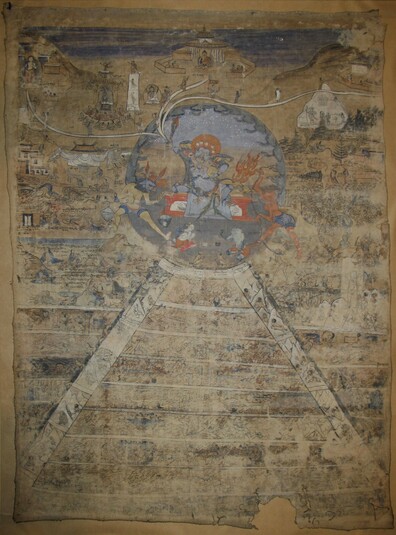
Item: Yama: Lord of Hell
| Origin Location | Tibet |
|---|---|
| Date Range | 1800 - 1899 |
| Lineages | Buddhist |
| Material | Ground: Cotton |
| Collection | Private |
Classification: Deity
Yama, King of the Law, Lord of Hell, presiding over the various types of cyclic existence. (See the Outline Page - Yama, Worldly Being, Judge of the Hell Realm, Wheel of Life Main Page and Outline Page).
This painting is one of the most unique presentations of the worldly condition. It follows somewhat the theoretical formula of a Wheel of Life painting but diverges dramatically with a heavy emphasis on the image of Yama and a detailed depiction of the Buddhist Hell Realms. What is clearly missing in this painting from the more traditional compositions are [1] the circular format, [2] the outer circle with images representing each of the Twelve Links of Dependent Arising and [3] the Three Animals representing the three poisons - rooster, pig and snake, at the hub of the Wheel of Life.
In the upper half of the composition is the figure of Yama, blue, wrathful, with one face and two hands, seated on a throne. In the upraised right hand he holds a wooden butchers stick for marking the carcass of the deceased before cutting. In the left hand is a mirror for reflecting the truth of good and bad actions - the karma of the deceased.
At the sides are two attendant figures. On the left the attendant holds a set of scales for determining the weight of good deeds and bad deeds. On the right an attendant drags a deceased towards Yama - pulled with a lasso tied about the neck. Two figures kneeling below, attendants of Yama, roll the the dice, black and white, determining the fate of two naked figures cowering in front.
Yama, Lord of Death in this context is understood to be a living being of the Ghost Realm who acts as the judge of the beings about to enter the Hell Realm. He is not a god or a deity, he is a living being of the Ghost Realm. Descriptions of Yama and the Hell Realms are described in the Pali and Sanskrit Sutras of early Buddhism and found in the Abhidharmakosha of Vasubhandu. (See the Yama Main Page, Yama Outline Page, and Yama Forms Outline Page, also see the narrative of Maudgalyayana retrieving his mother from hell).
Death, holding the circle of the Wheel of Life in painted depictions is a personification of death and impermanence and not seen or perceived of as a living being, god or deity. The early models of the Wheel of Life present five divisions of beings; gods, humans, animals, ghosts and hell beings. Later models from Central Asia and China also divide the gods into two groups, happy gods and jealous gods. In this model the two types of gods are always depicted at war with each other. In the Himalayas and Tibet both models of five and six divisions are found and explained according to different commentarial sources.
The heaven of Sukhavati, the pureland of Amitabha Buddha is above. The Animal and Human realms are to the right of Yama. The Asuras have been placed on the left of Yama and below a tree that blossoms and bears fruit in the heavens.
Below all of that and taking up more than half of the composition of the painting are the Eight Hot and Eight Cold Hells along with the the Occasional Hells which stand between the lower hell realms and the human and animal realms above.
This painting is not a traditional depiction of the Wheel of Life but rather a painting highlighting Yama as the central focus. Only a third of the upper composition is devoted to the higher realms along with the animals and ghosts. Two thirds of the composition are clearly devoted to depicting and documenting with inscriptions the many hell realms.
Jeff Watt 6-2009 [updated 4-2011]
Wheel of Life Main Page
Ritual Object: Mirror (Hand Attribute)
Subject: Hell (Main Page)
Subject: Hell, Yama (Judge in Hell)
Wheel of Life: Iconography
Subject: Hell, Yama, Religious Context
Collection: Chaofu Collection


